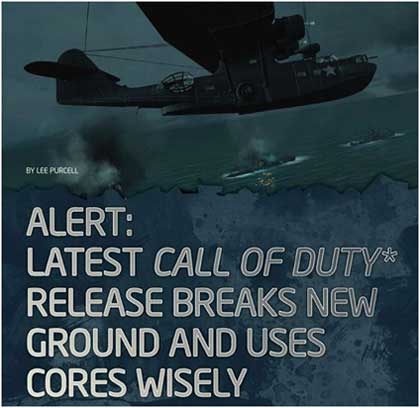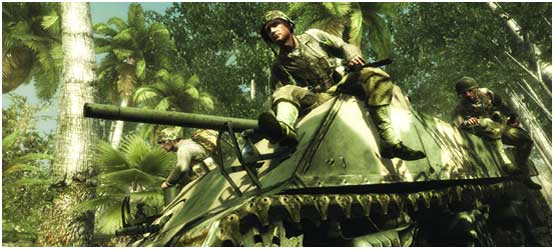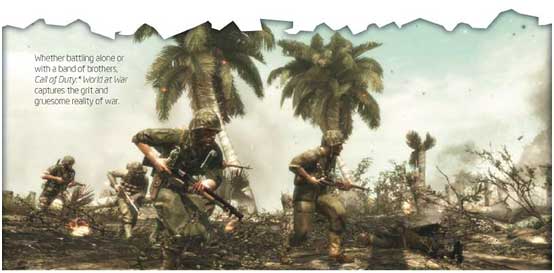Call of Duty 5: Technical Roundup: Difference between revisions
m →Intro |
|||
| Line 8: | Line 8: | ||
== Intro == | == Intro == | ||
The target is in the sights: Take an enduring game franchise and create a new release that keeps gamers roundly entertained while exploiting the latest PC platform advances. To that end, a seasoned cross-platform development team at Treyarch, experienced in the genre of multiplayer shooters, approached Call of Duty | The target is in the sights: Take an enduring game franchise and create a new release that keeps gamers roundly entertained while exploiting the latest PC platform advances. To that end, a seasoned cross-platform development team at Treyarch, experienced in the genre of multiplayer shooters, approached Call of Duty: World at War with a distinct mission: Release the PC and console versions, through the publisher Activision, on the same date and with comparable features. Boasting a track record that includes Spiderman 1 & 2 and over five years of simultaneous cross-platform releases, the Treyarch development team had the chops to pull off this latest release.<br> | ||
== Fire, particle effects, and physics == | == Fire, particle effects, and physics == | ||
Revision as of 16:19, 16 July 2010

Intro
The target is in the sights: Take an enduring game franchise and create a new release that keeps gamers roundly entertained while exploiting the latest PC platform advances. To that end, a seasoned cross-platform development team at Treyarch, experienced in the genre of multiplayer shooters, approached Call of Duty: World at War with a distinct mission: Release the PC and console versions, through the publisher Activision, on the same date and with comparable features. Boasting a track record that includes Spiderman 1 & 2 and over five years of simultaneous cross-platform releases, the Treyarch development team had the chops to pull off this latest release.
Fire, particle effects, and physics
They are powerfully enhanced through threading and new algorithms.
The high-resolution, high-frame rate objectives for Call of Duty*: World at War put considerable demands on the target platforms, an area where the benefits of multi-core processing become evident. In an interview with PC Games Hardware, Cesar Stastny, Director of Tools and Libraries at Treyarch, commented on the strong push toward the multi-threading of applications. “Game developers are among the lucky ones that had to start doing this [multi-threading] earlier,” Stastny said. “We have been developing games for the past three years for multi-processors. We learned a lot of lessons that other software developers have yet to go through.
Friends Don’t Let Friends Get Fragged
For the first time, Call of Duty: World at War has a multiplayer cooperative play (co-op) on the PC, a breakthrough that brings a new level of entertainment to gamers. Over the past ten years, some games have had a co-op mode that typically involved gamers playing with or against computer-generated bots, but if a gamer wanted to play through the entire campaign, they were on their own. With Treyarch’s new multiplayer co-op mode, up to four human players can experience the entire campaign together as one single team. One of the technical challenges that was overcome during development involved the complexity of letting four players connect and interact over the Internet on four separate machines, each with its own individual strengths. The smoothness of gameplay in co-op attests to the success in this area.
A newly added competitive co-op mode combines the multiplayer and single-player approaches. An individual player is playing through the single-player storyline in real time, but also gains points for kills and accumulates streak modifiers, which increase the overall point number. However, if a player gets killed and goes down, a teammate can revive him, but the player loses points for getting shot, while at the same time the teammate gains points. This provides a very different dynamic to the gameplay.
Developing Call of Duty
The core development team producing Call of Duty: World at War has a storied history dating back to an earlier company called Grey Matter, which produced the perennial favorite Castle Wolfenstein for the PC, as well as another popular PC video game, King Pin, in the late ‘90s. The team also created an expansion pack for Call of Duty 1 called United Offensive, which is widely considered the highest-rated expansion pack in game history.
This same team, after regrouping under the name Treyarch, has not rested on its laurels, despite having produced some of the most popular first-person shooters (FPS) in the history of gaming, including Return to Castle Wolfenstein, which is still played today. Having devoted nearly two years to Call of Duty: World at War, Treyarch has focused its hard-won expertise on raising the reality quotient and packing this latest release with features that make the most of an advanced technology platform.
First Person Insights into Development
Visual Adrenaline talked to Cesar Stastny, director of Tools and Libraries, Krassimir Touevsky, lead programmer PC team, and Adam Saslow, associate producer PC, to gain insight into the development process for Call of Duty: World at War, which sometimes kept developers hammering away on their keyboards for 18 to 20 hours at a stretch during the demanding, yet rewarding, process.
Visual Adrenaline: Have there been any particular advances in the Modern Warfare engine to adapt it for this latest Call of Duty release?
Cesar: The Call of Duty: Modern Warfare engine was already multi-threaded and running really well on dual-core systems. We completely utilized its worker threads system and threw a lot more work at this thread to crunch. We added new full-screen effects, dynamic water, fire, and burning effects, dynamic foliage, our own physics library, sound occlusion, and vehicles. We added squads to multiplayer and an entirely new cooperative gameplay mode. And, because it is more fun to play with your friends, we added a Friends list and game invites to the PC version.
Visual Adrenaline: How well versed is your development team in multi-threading techniques?
Krassimir: The core of the team is comprised of engineers that spent the last three years working on high-profile, cross-platform, next-gen titles—so we’re well versed in multi-threading. Intel supplied us with their latest tools, including the Intel® VTune™ Performance Analyzer and the Intel® Thread Profiler, which are absolutely best-in-class. They also provided formal training to introduce some of the engineers to the tools. And, our engineers who had used the tools in the past benefited from learning about all the latest features.

Visual Adrenaline: What kinds of challenges did you have to deal with to create the co-op feature?
Adam: The biggest challenges we faced when implementing co-op were network traffic and the fact that one player’s machine doubles as the server. Our multiplayer game comes with a dedicated server that can be run on a virtualized server at hosting companies. This unloads the players’ machines from computing the game state. But for co-op we had to use the machine that is hosting the match to run both the client and the server. Also, co-op maps are much larger than the multiplayer maps because they are actually the same as our single-player campaign maps. A lot of scripting events happen in these maps, which increases the load on the server as well as on the network layer. To reduce the impact on the server, we moved some of the scripting to the client. To some degree, this is possible because of the availability of more cores and more threads, providing additional headroom without compromising gameplay action.
Visual Adrenaline: What were your programming objectives for the release of Call of Duty: World at War? What new technologies did you exploit?
Adam: We wanted the PC version to match or exceed the game experience on the console. PC gamers who invest in better CPUs and GPUs will get higher resolutions (1650x1080, 1980x1200) and higher frame rates than are possible on the consoles. We believe the PC platform’s ability to scale in both areas allows PC gamers to realize improved, more realistic gameplay.I have been building software on Intel hardware since the early days of personal computing. It is always exciting to see what we can achieve with their continually evolving techchnology.
- Cesar Stastny, Director of Tools and Libraries, Treyarch
Visual Adrenaline: Which tools did you use to complete the product development and optimization?
Cesar: We used VTune and the Thread Profiler. We already had a threading library in place, but we will definitely consider Intel® Threading Building Blocks in our future development toolset. Using Intel’s tools, we managed to resolve some thread synchronization issues in our engine and to improve our threading model overall by reducing the amount of synchronization primitives and waits. Because of this, PC gamers will enjoy smoother gameplay, as well as a more immersive experience when playing Call of Duty: World at War.
Visual Adrenaline: What is the most difficult problem in terms of keeping the frame rates and video quality high?
Adam: You really need good frame rates for shooters. We started with the best FPS game engine available, which was already performing well. All we had to do from a technical standpoint was add more visuals, physics, and other features without dropping the frame rate. We added ocean simulation, dynamic foliage, improved rag-doll physics, realistic vehicle simulation, and more. Physics, in particular, makes heavy use of the processor, so the use of parallelism serves up strong dividends. I am happy to report that the frame rate is still solid.
Visual Adrenaline: Any tips or guidelines for other developers working on similar types of projects?
Cesar: Get the Intel performance tools early in your development cycle—even if you are doing console development. They can help you optimize your tools and art pipeline before you hit full production.
Former Quake* 3 world champion Kornelia Takacs brings a sharp competitive drive to Treyarch design work. Kornelia works closely with Cesar Stastny, Krassimir Touevsky, and Adam Saslow to refine many of the PC-specific aspects of the game.
Kornelia got hooked on competitive gameplay when her roommate downloaded Qtest for Quake 1. “That was the first time I experienced what it feels like to play an FPS game against another person!” she said. “Needless to say, once Quake was released I continued playing. I began gaming on a more serious level after I won a tournament that held its finals at GDC. I joined the Cyberathlete Professional League (CPL) and I continued competing at tournaments for several years.”
Calm nerves and a steady demeanor are prerequisites both for tournament play and game development. “You must have the ability to keep calm during your match whether you are winning or losing,” Kornelia observed. “Strategy and timing are crucial. Working at Treyarch, I have the opportunity to play our game, but playing in team games at the office is a more relaxed and pressure-free.
”Kornelia is feeling positive about the Call of Duty: World at War release. “We have great features on the PC,” she said, “that make it easier for you to find servers that your friends and clan mates are playing on. I like that the multiplayer game mode settings on the PC have all of the options that appear on the Xbox* 360 version. Capture the flag . . . need I say more? Nazi Zombies mesmerized everyone at our office. Even people that were working on different titles were playing it for hours on end (after their regular work day, of course).”
Gaming Trends and Future Developments
Mark Lamia, studio head at Treyarch, sees a number of trends that are changing computer games. “Aside from great leaps in power that we as game developers will continue to harness in areas like graphics, physics, AI, and audio,” he said, “we are seeing more and more gamers spending their time online playing our games and participating in online communities.”
In response to this trend, Treyarch is investing heavily in all aspects of online gaming. Call of Duty: World at War was designed for online gaming, incorporating competitive multiplayer and—for the first time in the franchise history—online co-op play. To keep the online community grounded and informed, Treyarch also enhanced the CallofDuty.com site, where members gather to critique, comment, and contribute.
Mobile gaming is another prime area of interest. Mark noted, “I remember a couple of years back seeing some of the first laptops appear at a QuakeCon* and noticing how convenient it was for gamers to get together and play or have LAN parties.”
Mark was convinced at that point that as long as the hardware was powerful enough, laptops would be recognized as serious gaming rigs. “As CPU and graphic capabilities continue to improve in laptops,” Mark observed, “they will continue to grow as a key platform for gaming.” In support of this trend, Intel Software and Services Group offers the Intel® Laptop Gaming Technology Development Kit (TDK), a set of libraries that make game code more aware of the laptop environment (including battery life and wireless strength).
The future looks bright for PC gaming as platform advances continue to expand possibilities. “Treyarch is looking forward to supporting all of the exciting capabilities that the PC has to offer to gamers,” Mark said, “and continuing to work with Intel to help us fully realize that power, so that PC users can continue to enjoy higher-resolution visuals, larger-scale multiplayer games hosted on customizable and dedicated servers, and more user-created mods.”

About the Author
Having survived the frenetic energy of Silicon Valley in its heyday, Lee Purcell now writes on high-tech and alternative energy topics from a rural outpost in the Green Mountain State. Lee blogs on alternative energy topics at This site.
Source
Source Article can be found HERE
--Zeroy. 16:05, 16 July 2010 (UTC)
